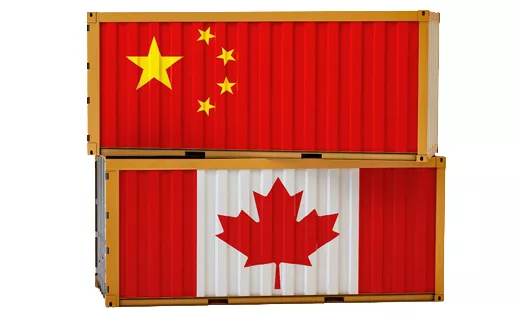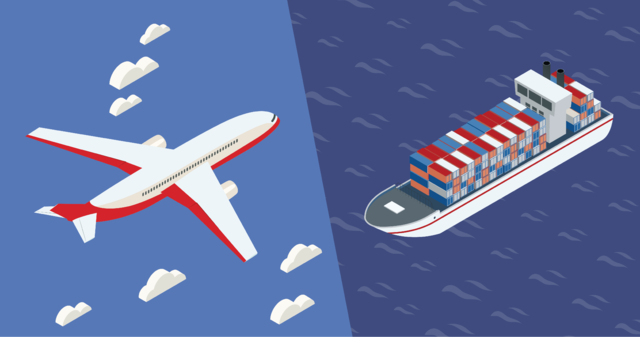- By TOP CHINA FREIGHT
- September 11, 2025
- Shipping
Table of Contents
Shipping from China to Canada can be challenging due to complex logistics, customs requirements, and fluctuating shipping costs. Businesses often struggle to find a reliable freight forwarder who ensures timely deliveries, transparent pricing, and seamless import/export handling. This guide will help you understand the best freight forwarder options, compare shipping methods, and optimize your supply chain for shipments from China to Canada.

What Are the Key Services of a Freight Forwarder from China to Canada?
A professional freight forwarder handles every aspect of shipping from China to Canada, including booking cargo space, managing documentation, customs clearance, and ensuring timely delivery. Most forwarders also offer value-added services such as cargo insurance, warehousing, packaging, and supply chain consultation.
Key long-tail services include:
- Door-to-door delivery from China to Canada
- Assistance with customs clearance and compliance
- Real-time tracking and delivery schedule updates
- Consolidation of small shipments to reduce shipping costs
Moreover, experienced freight forwarders can advise on optimal routes, shipment methods, and best practices for handling sensitive cargo. This minimizes delays, reduces hidden costs, and improves supply chain efficiency.
How Much Does It Cost to Ship from China to Canada?

Shipping costs vary depending on cargo type, volume, shipping method, and additional services. Here’s a typical cost comparison for different shipping methods:
| Shipping Method | Average Cost (per 20ft container) | Transit Time | Pros | Cons |
|---|---|---|---|---|
| Sea Freight | $2,200–$3,500 | 20–35 days | Cost-effective for large cargo | Longer transit, port congestion |
| Air Freight | $4–$8 per kg | 3–7 days | Fast delivery, reliable schedule | Expensive for heavy shipments |
| Rail Freight | $3,000–$5,000 | 15–25 days | Medium cost, safer than sea | Limited routes, customs delays possible |
| Express Courier | $10–$25 per kg | 1–5 days | Door-to-door, minimal handling | Very high cost, weight restrictions |
What Are the Main Shipping Methods from China to Canada?
Shipping from China to Canada typically involves three primary methods:
Sea Freight:
Ideal for large shipments, sea freight is cost-effective but slower. FCL (Full Container Load) and LCL (Less than Container Load) options allow flexibility based on cargo volume.
Air Freight:
Preferred for time-sensitive goods. Air freight offers quick delivery, real-time tracking, and reliable schedules but is significantly more expensive.
Rail Freight:
Rail is a middle ground in cost and transit time. It’s suitable for destinations near rail terminals but has limited network coverage in Canada.
Comparison Table: Shipping Methods
| Feature | Sea Freight | Air Freight | Rail Freight |
|---|---|---|---|
| Cost | Low | High | Medium |
| Transit Time | 20–35 days | 3–7 days | 15–25 days |
| Reliability | Moderate | High | High |
| Cargo Size | Unlimited | Limited | Moderate |
| Customs Complexity | Moderate | Low | Moderate |
How to Choose the Best Freight Forwarder China to Canada?
Selecting the right freight forwarder involves evaluating experience, network, pricing transparency, and value-added services. Consider the following criteria:
Experience:
How long has the forwarder operated in China-to-Canada shipping?
Network Coverage:
Are they partnered with major carriers and ports?
Customer Service:
Can they provide real-time updates and solve issues efficiently?
Customs Expertise:
Do they manage paperwork, tariffs, and compliance smoothly?
Insurance & Risk Management:
Are your goods protected against loss or damage?
Additionally, reading client testimonials and requesting case studies helps gauge reliability. A competent forwarder reduces delays, minimizes shipping costs, and ensures goods arrive in optimal condition.
What Documents Are Required for Shipping from China to Canada?

Customs documentation is critical for smooth import/export. Missing or incorrect documents can lead to costly delays.
Key documents include:
| Document | Purpose | Required By |
|---|---|---|
| Commercial Invoice | Details goods, value, and HS codes | Canada Customs |
| Packing List | Lists cargo items, weight, dimensions | Carrier & Customs |
| Bill of Lading | Proof of shipment, contract between shipper & carrier | Carrier & Importer |
| Certificate of Origin | Confirms country of manufacture | Customs & Trade Agreements |
| Import License | Required for restricted goods | Canada Customs |
How Long Does It Take to Ship from China to Canada?
Transit times depend on the shipping method, departure port, and destination port.
Typical transit times are:
| Shipping Method | Average Transit Time | Notes |
|---|---|---|
| Sea Freight | 20–35 days | Longer if port congestion occurs |
| Air Freight | 3–7 days | Fastest, ideal for urgent shipments |
| Rail Freight | 15–25 days | Limited by rail terminal locations |
| Express Courier | 1–5 days | Small parcels only |
Delays can occur due to customs inspections, bad weather, or carrier scheduling changes. Using a freight forwarder with strong logistics expertise ensures accurate delivery schedules and helps mitigate potential risks.
Case Study: Optimizing Supply Chain from Shanghai to Toronto

A mid-sized electronics company needed to ship 500 units of products from Shanghai to Toronto. Initially, they tried shipping via sea freight with minimal support, which resulted in a two-week delay at customs.
After partnering with a professional freight forwarder:
Shipping Method:
Air freight for critical components, sea freight for bulk products
Customs Clearance:
Forwarder handled paperwork, reducing delays by 80%
Tracking & Updates:
Real-time notifications improved inventory planning
Cost Savings:
Consolidation of shipments reduced sea freight costs by 15%
This example highlights the importance of using an experienced forwarder for timely delivery, cost management, and overall supply chain efficiency.
Should You Consolidate Shipments from China to Canada?
Consolidation combines multiple small shipments into one container, reducing shipping costs and improving logistics efficiency.
| Benefit | Explanation |
|---|---|
| Lower Costs | Sharing container space reduces per-unit cost |
| Simplified Documentation | Fewer shipments reduce paperwork burden |
| Risk Management | Consolidated cargo can be insured more easily |
| Eco-Friendly | Reduces transportation emissions |
Air vs Sea Freight: Which Is Right for Your Shipment?

Choosing between air and sea freight depends on urgency, cost, and cargo type.
| Factor | Air Freight | Sea Freight |
|---|---|---|
| Cost | High | Low |
| Transit Time | Fast (3–7 days) | Slow (20–35 days) |
| Cargo Size | Small | Large |
| Reliability | High | Moderate |
| Ideal For | Electronics, perishable goods | Bulk goods, non-urgent shipments |
Conclusion
Shipping from China to Canada requires careful planning, the right freight forwarder, and thorough knowledge of customs, transit times, and shipping costs. By comparing sea, air, and rail freight, preparing accurate documentation, and consolidating shipments where appropriate, businesses can reduce expenses, prevent delays, and maintain a reliable supply chain. Partnering with an experienced forwarder ensures smooth logistics, timely delivery, and overall operational efficiency.
Need a Shipping Quote?
If you want expert guidance and peace of mind, our team is ready to assist.
TJ China Freight offers tailored solutions to help businesses of all sizes ship more reliably from China.

FAQ
Q1:How do I compare freight forwarders from China to Canada?
Check pricing transparency, transit time reliability, customs support, and logistics expertise. Request multiple quotes to select the best freight forwarder China to Canada for your shipment needs.
Q2:Can I ship fragile items from China safely?
Yes, use a freight forwarder with proper packaging services, insurance, and careful handling. This ensures safe delivery while managing shipping costs and supply chain efficiency.
Q3:What is the fastest shipping method from China to Canada?
Air freight is the quickest, typically 3–7 days. It suits urgent shipments while ensuring timely delivery schedules and smooth customs clearance.
Q4:How do I reduce shipping costs from China?
Consider consolidating LCL shipments, using sea freight for bulk items, and negotiating rates with your best freight forwarder China to Canada.
Q5:Are there customs restrictions I should know about?
Yes, certain goods require import licenses or certificates. Work with your freight forwarder to comply with Canada Customs and avoid transit delays.
